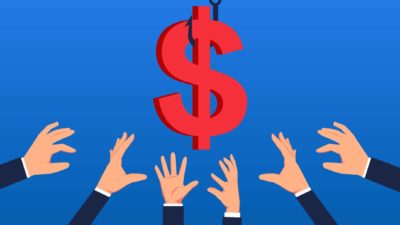What, exactly, is a CEO's job?
It seems like a simple question. Maybe you even have a simple answer for it.
Yes, the buck stops at the big desk in the corner office. That's true.
So 'everything' might be a good answer.
Or, if you're focussed on activity and outcomes, perhaps 'results' would be more fitting.
And they certainly get hired and fired (and sometimes paid obscene bonuses) on that basis, so it's not wrong.
But if you were a board member of an Australian public company, or its Chair, what would you want the CEO to actually spend her time doing?
As a long-term investor, and someone who hopes to hold my shares for years (and hopefully decades) to come, I care about this quarter's results.
A bit.
But I care far more about what the CEO is building.
How are they setting the company up for long term success?
And in that vein, I reckon a company board should be focused on the CEO's responsibility for three things:
— Culture
— Hiring; and
— Capital allocation
No, not necessarily in that order, but I don't think we need to get caught up in trying to force-rank just three items.
Let's start with culture.
I agree with management guru Peter Drucker that 'culture eats strategy for breakfast'.
Culture underpins how a company operates, what it does and how its people usually behave. There is no one-size-fits-all answer to the 'right' culture, by the way, but getting it right is important.
The mafia (reportedly) has a very strong culture. So does Surf Life Saving. It binds people together, tells them what's expected and valued, and helps everyone pull in the same direction.
Hiring is both more important than, but also a proxy for, results. The CEO can't make all of the sales calls. Can't approve every marketing program. And doesn't stand on the factory floor, running quality control.
She has people to do that.
And it's the quality of those people that she should be focused on. Are the right people, with the right skills, abilities and experiences, in the right chairs?
Or, as Jim Collins wrote, in what I think is the best business management book ever, Good To Great:
"If we get the right people on the bus, the right people in the right seats, and the wrong people off the bus, then we'll figure out how to take it someplace great."
So hiring (and firing) rather than short-term results, should be a key focus. Get the people right and the results have a very good chance of following.
And then we have capital allocation.
It's probably the most underappreciated role a CEO has.
It's hard to see. Hard to (truly) evaluate.
Huh? Hard to evaluate? Isn't that why we have a set of financial statements?
Well yes… but it only tells you so much.
It doesn't tell you what deals she passed up. It doesn't tell you what would have happened otherwise.
(As humans, we focus way too much on 'active' decisions – where something is 'done' – and ignore passive decisions (or non-decisions), which can be just as, or more, impactful. But that's a topic for another day).
But however you measure it – or broadly assess it – capital allocation is a vital part of the CEO's remit.
Consider these examples:
Every dollar invested in an activity or asset could have been invested elsewhere, or returned to shareholders.
A dividend paid, when there are growth options elsewhere, means less value is created (see: Berkshire Hathaway – I own shares, for the record).
Or, a dividend not paid, and instead used for a bad acquisition, can destroy huge amounts of value (Isentia's purchase of King Content might be an example).
Should they build a new plant, which is cheaper, per-unit, and tie up huge amounts of shareholder capital, or pay a little more for each widget, and buy them from someone else, freeing up valuable capital?
How much should we borrow, and how much of the company's cash should we use? The former is cheaper, but riskier. The latter is safer, but weighs on returns.
You get the gist.
But there's something else – something I want to focus on for just a minute.
Shares.
Specifically, the company's own shares.
Every time a CEO issues more shares – executive remuneration, as 'currency' for an acquisition, or even through a dividend reinvestment plan – we each own a little less than we did before.
For what benefit? Well, that depends.
Sometimes the shares are used judiciously. Other times, well, the CEO and board seem to neither know, nor care.
Block Inc (ASX: SQ2) (nee Square) seems to have done a brilliant deal using then-very expensive shares to buy Afterpay. The deal was done at around US$250 per Block share. They now trade for US$88 – just over one-third of that price. Put another way, Block would have had to issue three times as many new shares at US$88 than they did at US$250.
(Of course, many say Afterpay shares were similarly overvalued at that point, too, so perhaps there's some poetic justice… but that's another one for another day!)
On the other hand, there are companies now entertaining takeover offers at share prices lower than they have been in the past.
Now, if these offers truly represent compelling value – enough that a CEO and board would recommend we take them – why wasn't management shopping the company around at higher prices?
One example is this morning's announcement of a 'takeover offer' for aerial imaging company Nearmap.
The shares closed on Friday at $1.51.
The takeover offer – well, "a non-binding indication of interest" – is at $2.10 per share.
Good huh?
Well, the shares traded for $4.12 a piece back in 2019.
And at or around $2.10 for most of 2021.
No deal was done.
But now, $2.10 is a good price?
Frankly, it may well be.
Perhaps the business has deteriorated.
Maybe the market interest in this sort of business has softened to the point that $2.10 is the best that's likely to be on offer.
But it's worth wondering why they'd do this deal, at this price, at this time, but not another deal at a higher price in the past.
Without being on the inside, it's hard to pass judgment.
But you can see how and why capital allocation matters.
If Nearmap Ltd (ASX: NEA) get this right, it will create real value for shareholders.
If they get it wrong, shareholders can rightly wonder why they're doing this deal at this price, rather than shopping the company around somewhere north of $3.
Hindsight bias?
I guess.
But it's worth asking what a business might be worth in future.
Qantas Airways Limited (ASX: QAN) famously knocked back a bid at $5.45 in 2007 (the bid went ahead, but failed to achieve majority shareholder acceptance).
And in 2022?
The shares are trading at $4.68
Even pre-COVID, at a – very brief – high of $7.35, the gain since 2007 was less than 2.5% per annum.
On the flipside, back in 2002, Yahoo! had the chance to buy Google for US$1 billion. The former is now a shell of its old self and the latter – I own shares in its parent company, Alphabet – is now worth US$1.59 trillion (that's US$1,590 billion)!
Yes, predictions are hard. Especially about the future.
But you can see just why those capital allocation decisions are so important.
Yahoo! should have done that deal.
Afterpay shareholders should be happy about the price they got, but less so if they held onto their new Square shares, rather than selling for cash.
Meanwhile, Block shareholders should be pretty happy about the price they got for Afterpay, at least measured in their own shares.
Fairfax Media Limited (ASX: FXJ) should have bought Seek Limited (ASX: SEK) when it had the chance.
AMP Ltd (ASX: AMP) should have sold itself to almost anyone at almost any point over the last 20 years, so terrible has been the value destruction in the meantime.
CEOs (and their boards) should always have a strong view about the approximate underlying value of their company's shares.
If the shares get too cheap, they should use company money (if they have it – another capital allocation choice!) to buy back those undervalued shares, creating value for continuing shareholders.
If the shares get too expensive, they should be looking for opportunities to sell the company, to issue more shares to raise cash, or to use those overvalued shares to make an acquisition.
But, just like those of us who invest in their companies, they shouldn't be letting the market tell them what their shares are actually worth.
For CEOs, as for investors, the market is there to serve us, not to inform us, as Warren Buffett says.
If they get the price wrong, all of the hard work done to build a great business can be for (almost) naught.
Is your CEO up to scratch on capital allocation? It's a question worth asking.
Fool on!









